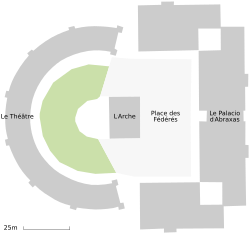| Les Espaces d'Abraxas | |
|---|---|
 | |
 | |
| General information | |
| Architectural style | Postmodernism |
| Classification | Social Housing |
| Town or city | Noisy-le-Grand |
| Country | France |
| Coordinates | 48°50′24″N 2°32′35″E / 48.8401°N 2.5431°E |
| Construction started | 1978 |
| Construction stopped | 1982 |
| Opened | 1983 |
| Technical details | |
| Material | Prefabricated Concrete |
| Size | 47,000 m2 (510,000 sq ft) |
| Design and construction | |
| Architect(s) | Ricardo Bofill |
| Architecture firm | Ricardo Bofill Taller de Arquitectura |
| Other information | |
| Public transit access | Réseau Express Régional (RER) |
Les Espaces d'Abraxas is a high-density housing complex in Noisy-le-Grand, approximately 12 km (7.5 mi) from Paris, France.[1] The building was designed by architect Ricardo Bofill and his architecture practice Ricardo Bofill Taller de Arquitectura (RBTA) in 1978[2] on behalf of the French government,[3] during a period of increased urbanisation across France after World War II.[4] This rapid urbanisation led to overcrowding and insufficient housing in Paris.[5] To offset this, the French government implemented a project to create five 'New Towns' on the outskirts of the city.[5]
Architect Ricardo Bofill's projects, including Les Espaces d'Abraxas, are rooted in his left wing ideals.[6] The building's post-modern design uses classical motifs and new building technologies to achieve a luxury aesthetic previously reserved for upper classes.[7] Despite receiving criticism, the building was an early success for Bofill, and brought him international success and praise.[3] The building has been used as a backdrop in film and TV, including in Brazil (1985) and The Hunger Games: Mockingjay – Part 2 (2015).[8]
- ^ Phelps, Nicholas A.; Parsons, Nick; Ballas, Dimitris; Dowling, Andrew (2006). "Noisy-le-Grand: Grand State Vision or Noise about Nowhere?". Post-suburban Europe : planning and politics at the margins of Europe's capital cities. Palgrave Macmillan. p. 122. ISBN 978-0-230-00212-8. OCLC 750491768.
- ^ Cite error: The named reference
:9was invoked but never defined (see the help page). - ^ a b Ayers, Andrew (2004). The architecture of Paris : an architectural guide. Stuttgart: Edition Axel Menges. p. 355. ISBN 3-930698-96-X. OCLC 51527007.
- ^ Farro, Antimo Luigi; Maddanu, Simone (15 May 2019), "Occupying the city", Youth and the Politics of the Present, Routledge, pp. 141–152, doi:10.4324/9780429198267-11, ISBN 9780429198267, S2CID 188982827
- ^ a b Cite error: The named reference
:7was invoked but never defined (see the help page). - ^ Cite error: The named reference
:20was invoked but never defined (see the help page). - ^ Marta, Tobolczyk (2021). Contemporary architecture. The genesis and characteristics of leading trends. Cambridge Scholars Publishing. ISBN 978-1-5275-7039-9. OCLC 1293294352.
- ^ Cite error: The named reference
boom2017was invoked but never defined (see the help page).